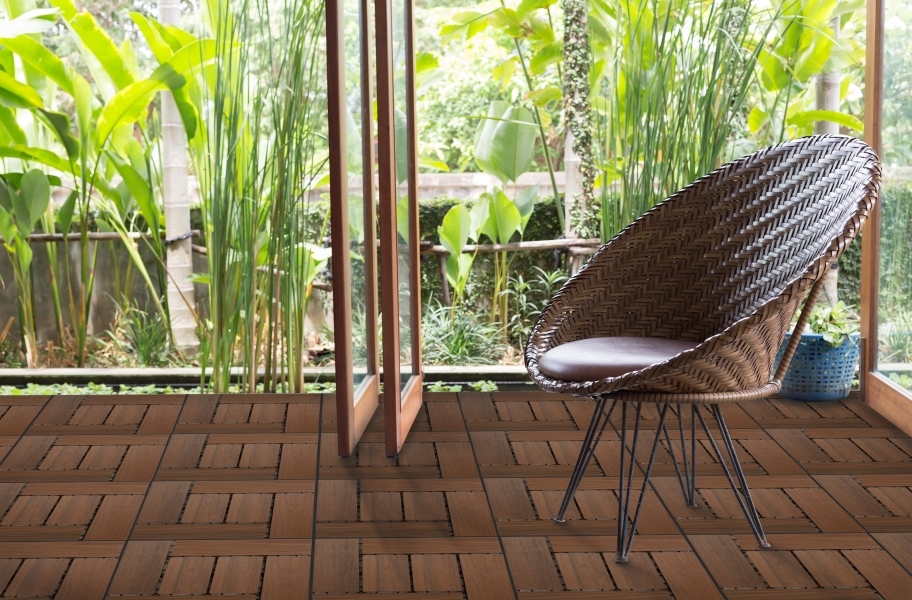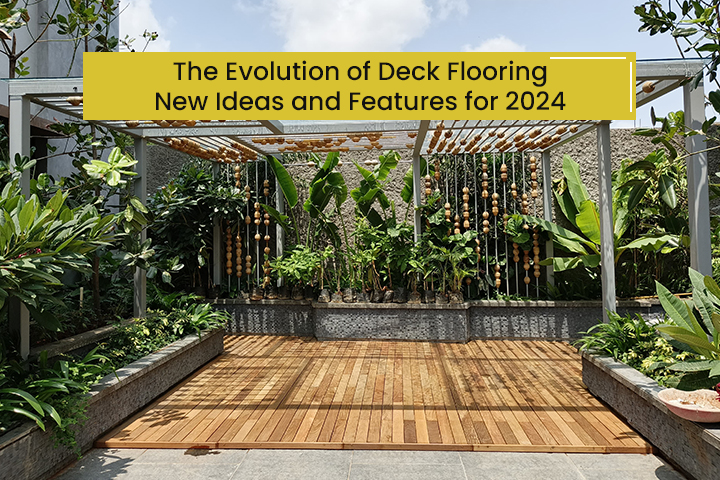Decks have long been cherished as extensions of our living spaces, offering a seamless blend of indoor comfort and outdoor serenity. As the demand for outdoor living spaces continues to rise, deck flooring has evolved beyond traditional wood planks. In 2024, new ideas and innovative features are transforming how we design, build, and experience decks. Whether you’re considering a new deck or upgrading an existing one, these trends and features will inspire you to create a space that’s not only beautiful but also sustainable, durable, and functional.
1. Sustainable and Eco-Friendly Materials
Sustainability is at the forefront of home design, and deck flooring is no exception. Homeowners and designers are increasingly opting for eco-friendly materials that reduce the environmental impact of construction. Some popular sustainable options include:
- Bamboo Decking: Bamboo is a rapidly renewable resource, making it an excellent choice for eco-conscious homeowners. It’s durable, resistant to pests, and has a natural, earthy aesthetic.
- Recycled Composite Decking: Made from recycled wood fibers and plastic, composite decking is an environmentally friendly alternative to traditional wood. It’s low-maintenance, resistant to splintering, and available in a variety of colors and textures.
- Thermally Modified Wood: This process involves heating wood to high temperatures to increase its durability and resistance to moisture, rot, and insects. Thermally modified wood offers the beauty of natural wood with enhanced longevity.
2. Advanced Composite Decking
Composite decking has been around for a while, but the latest advancements in technology have taken it to a new level. In 2024, composite decking is more realistic and durable than ever before. New features include:
- Enhanced Durability: Modern composite decks are engineered to withstand extreme weather conditions, including UV rays, heavy rain, and freezing temperatures. This makes them ideal for various climates and reduces the need for frequent maintenance.
- Realistic Wood Grain: Advanced manufacturing techniques have made it possible to replicate the look and feel of real wood grain in composite decking. Homeowners can enjoy the aesthetic appeal of wood without the drawbacks of maintenance and susceptibility to damage.
- Color Stability: Innovations in pigmentation technology ensure that the colors of composite decks remain vibrant and fade-resistant for years. This means your deck will look as good as new, even after years of exposure to the elements.

3. Modular Decking Systems
Modular decking is a game-changer for DIY enthusiasts and homeowners looking for flexibility in their deck design. These systems consist of pre-fabricated panels or tiles that can be easily assembled and disassembled, allowing for customization and easy repairs. Some benefits of modular decking include:
- Ease of Installation: Modular systems are designed for easy installation, making them a great option for DIY projects. They often come with interlocking features, eliminating the need for complex tools or expertise.
- Versatility: With modular decking, you can mix and match different materials, colors, and patterns to create a unique look. This versatility extends to the ability to reconfigure or expand your deck in the future.
- Accessibility: Modular decks can be installed over existing surfaces, such as concrete or tile, making them a cost-effective solution for upgrading an old or damaged deck.
4. Smart Decking Features
As smart home technology continues to advance, it’s making its way into outdoor spaces as well. Smart decking is an emerging trend that integrates technology into the design and functionality of your deck. Some of the latest smart features include:
- Built-in LED Lighting: LED lights can be integrated into deck boards, stairs, and railings to enhance safety and create a cozy ambiance. These lights can be controlled remotely via smartphone apps, allowing you to adjust the brightness and color with ease.
- Heated Decking: Heated decking systems are designed to prevent ice buildup during the winter months, making your deck safer and more accessible year-round. These systems are particularly useful in colder climates where ice and snow are common.
- Weather Sensors: Smart decks can be equipped with weather sensors that automatically adjust lighting, heating, and even retractable awnings based on real-time weather conditions. This ensures your deck remains comfortable and functional in any weather.

5. Multi-Level Decking Designs
Gone are the days of simple, single-level decks. Multi-level decking is a trend that’s gaining popularity for its ability to create distinct zones for various activities. Whether you want a dining area, a lounging space, or a play area for children, multi-level decks can accommodate multiple functions. Benefits include:
- Enhanced Aesthetics: Multi-level decks add visual interest and depth to your outdoor space. By varying the height and layout of each level, you can create a dynamic and inviting environment.
- Space Optimization: For homes with limited outdoor space, multi-level decks offer a practical solution by maximizing the available area. You can incorporate built-in seating, planters, and storage to make the most of your space.
- Privacy and Separation: Multi-level designs allow for better privacy and separation between different areas. For example, you can designate one level for relaxation and another for entertainment, ensuring everyone has their own space to enjoy.
6. Mixed-Material Decking
Another exciting trend in 2024 is the use of mixed materials in deck design. Combining different materials can create a unique, personalized look that reflects your style. Popular combinations include:
- Wood and Metal: Pairing natural wood with industrial metal elements creates a modern, rustic aesthetic. This combination is perfect for homeowners who want a deck that stands out from the crowd.
- Stone and Composite: Integrating stone or concrete elements into a composite deck adds texture and contrast. This mix is ideal for creating a sleek, contemporary look that’s both durable and low-maintenance.
- Glass and Wood: Glass panels in railings or as part of the deck surface can enhance the visual appeal of wood decking. This combination allows for unobstructed views while maintaining a clean, modern design.
7. Sustainable Deck Finishes
Protecting your deck from the elements is crucial for its longevity, but traditional finishes often contain harmful chemicals. In response, the market is seeing a rise in eco-friendly, sustainable deck finishes that are both effective and environmentally responsible. These finishes are:
- Water-Based Stains: Unlike oil-based stains, water-based options are low in VOCs (volatile organic compounds), making them safer for the environment and your health. They also offer easy cleanup and a wide range of color options.
- Natural Oils: Finishes made from natural oils, such as linseed or tung oil, penetrate deep into the wood, providing long-lasting protection without the use of synthetic chemicals. These oils enhance the natural beauty of the wood while offering excellent resistance to moisture and UV rays.
- UV-Protective Coatings: New finishes are being developed with advanced UV-blocking technology to protect your deck from sun damage. These coatings help maintain the color and integrity of your deck for years, even in harsh sunlight.

8. Biophilic Design Integration
Biophilic design focuses on connecting people with nature, and it’s making its way into deck design in 2024. This approach emphasizes the use of natural materials, greenery, and organic shapes to create a harmonious outdoor space. Key elements include:
- Living Walls: Incorporating vertical gardens or living walls into your deck design adds a lush, green element that enhances the connection with nature. These features also improve air quality and provide additional privacy.
- Natural Stone Accents: Integrating natural stone, such as flagstone or river rock, into your deck creates a seamless transition between the built environment and the natural landscape. Stone accents can be used for pathways, borders, or as a focal point.
- Water Features: Adding a water feature, such as a small fountain or pond, brings the soothing sound of water to your deck. Water features not only enhance the aesthetic appeal but also create a calming atmosphere.
Conclusion
Deck flooring in 2024 is all about innovation, sustainability, and personalization. Whether you’re drawn to the latest materials, smart technology, or biophilic design, there’s something for every homeowner looking to create a stunning and functional outdoor space. By embracing these new ideas and features, you can transform your deck into a true extension of your home a place where you can relax, entertain, and connect with nature in style.

